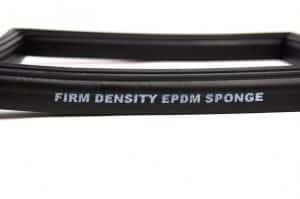Enclosure gasket design follows a simple formula. By choosing the right compound, hardness, and profile, you can fill the gap and seal-out the environment. Let’s take a look what you need to know so that you can get the best finished gaskets.
Enclosure Gasket Design and Compound Selection
Rubber comes in different compounds. Choosing the right one is about asking and answering three basic questions:
- Which enclosure gasket materials can withstand the environment?
- What are their advantages and disadvantages?
- How much do these gasket materials cost?
To achieve the right amount of environmental resistance for enclosure sealing, consider these four factors:
- Media
- Temperature
- Application
- Pressure
Here are some questions to ask about each one.
Media | Is there exposure to freshwater, saltwater, fuels, oils, or chemicals? Is this exposure incidental or long-term? |
Temperature | What are the minimum and maximum service temperatures? Are heat aging or thermal cycling potential risk factors? |
Application | What is the flange type, flange material, and bolt-hole pattern? Will the seal or gasket be installed or applied with PSA tape instead? |
Pressure | Does the sealing application involve high or low pressures? How could the pressure level affect seal compression. |
When you compare compounds, don’t just consider their costs. Look carefully at their advantages and disadvantages. For example, both EPDM and TPE can resist outdoor environments with wind, water, and weather. EPDM rubber costs less, but TPEs are available in tighter tolerances. TPEs also come in custom colors and are recyclable.
In the case of electrical enclosures, you may also need to compare commercial compounds to specialty compounds such as UL approved materials. Some applications require fire-rated materials. Specialty compounds have more robust properties but they’re also more expensive. They have higher minimum order quantities (MOQs), too.
Enclosure Gasket Design and Hardness
Enclosure gasket materials come in a range of durometers – a measure of hardness on the Shore A scale. During durometer selection, you may find yourself comparing sponge and solid materials. Solid rubber is usually harder, but that’s not always the case. The distinguishing feature of sponge rubber is a cellular structure that either permits (open cell) or prevents (closed cell) the passage of air, water, and gases.
As a rule, harder rubber is more impact resistant and softer rubber is more compressible. With enclosure sealing, a gasket that’s too hard may not allow a door to shut securely. Yet a softer gasket material that’s over-compressed won’t provide proper sealing either. Compression set, the permanent deformation of a material when an applied force is removed, can cause seal failure.
Enclosure Gasket Design and Profile Selection
The rubber profiles that are used with enclosure gaskets come in a variety of shapes. Four of the most common types are D,P, E, and lip seals.
- D-seals have a have a moon-shaped bulb that provides sealing under pressure and a flat, straight section that attaches with an adhesive such as PSA tape.
- P-seals have a rounded bulb and a flat stem. The bulb provides sealing under compression. The stem or tail is used for attaching the gasket with mechanical fasteners.
- E-seals have a half-moon bulb that supports compression, a tail that lays atop a substrate, and a gap or slot when an installer inserts metal bar stock.
- Lip seals have an edge or extended lip instead of a round bulb. Unlike other types of rubber profiles, they don’t need full compression to provide effective sealing.
Learn More About Enclosure Sealing
Enclosure gasket design starts with compound, hardness, and profile selection. Yet enclosure designers may also need design assistance or additional value-added services such as help with compound selection. To learn more about enclosure gasket design, contact Elasto Proxy.









